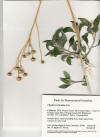|
Baja California Sur: SW Coast
|
Viguiera laciniata |
Viguiera parishii |
|
Viguiera parishii
|
Viguiera stenoloba Big Bend Natl. Park, TX, Nov. 1978
|
Viguiera reticulata
|
|
Guimarães D. O., W. S. Borges, C. Y. Kawano, P. H. Ribeiro, G. H. Goldman, A. Nomizo, G. H. Thiemann, G. Oliva, N. P. Lopes and M. T. Pupo. 2007. Biological activities from extracts of endophytic fungi isolated from Viguiera arenaria and Tithonia diversifolia. FEMS Immunol. Med. Microbiol. Dec. “A total of 39 endophytic fungi have been isolated from Viguiera arenaria and Tithonia diversifolia, both collected in São Paulo State, Brazil. The isolates were identified based on their ribosomal DNA sequences. The ethyl acetate (EtOAc) extracts of all endophytic fungi were evaluated for their antimicrobial, antiparasitic and antitumoral activity. Antimicrobial screening was conducted using an agar diffusion assay against three pathogenic microorganisms: Staphylococcus aureus, Escherichia coli and Candida albicans. Antiparasitic activity was determined by enzymatic inhibition of gGAPDH of Trypanosoma cruzi and adenine phosphorybosiltransferase (APRT) of Leishmania tarentolae. Antitumoral activity was tested against human T leukemia cells by the Mosmann colorimetric method. All extracts showed activity in at least one assay: 79.5% of the extracts were cytotoxic against leukemia cells, 5.1% of the extracts were active against S. aureus, 25.6% against E. coli and 64.1% against Candida albicans. Only one extract showed promising results in the inhibition of parasitic enzymes gGAPDH (95.0%) and three were found to inhibit APRT activity. The cytotoxic extract produced by the strain VA1 (Glomerella cingulata) was fractionated and yielded nectriapyrone and tyrosol. Nectriapyrone showed relevant cytotoxic activity against both human T leukemia and melanoma tumor cell lines.” |
||







